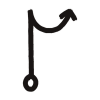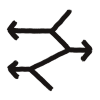C
D
M
S
Storytelling
Storytelling can be a lot of things, but in this entry, it is thought of as a choreographic practice of telling meaningful stories, in different registers, within the embodied and ambiguous space of encounters with others. It is a performative practice, in the world-making sense, and a fantastic practice, in the sense that it employs both fantasies and fun.
Ursula K. Le Guin, in an acceptance speak to the National Book Foundation in 2014, asks for writers who are “realists of a larger reality” [1]. A choreographic approach to storytelling can perhaps offer us exactly this – stories told through other realities, in other registers, through different mediums, for other audiences or from other bodies. Acknowledging that a good story can still offer content, politics, critique and engagement, perhaps the idea of the choreographic can help us think about the message and the messenger as being in a messy relationship with each other? All the stories we tell – about what is possible in the world, how the world ends, who runs the world – all of these stories does not simply reflect the world but is also part of creating it.
And if storytelling is a practising telling big enough stories [2], told through different mediums, these stories might not always be understood. They are perhaps untranslatable, or opaque [3], or demands a different kind of listening. Another way of tuning [4] in with, or resonating [5] with, our surrounding.
So, what about choreography? Choreography, and perhaps even more dance, can be thought of as a medium of thought which can create different stories of the world through the engagement of bodily practices. I suspect that many dancers are very well trained in sense perception, proprioception and group behaviour. Practices that can provide a different, sense-attuned, way of getting to know the world. To spend time in “a room for investment that is not directed” as the choreographer Alice Chauchat once told me, later asking: as the choreographer Alice Chauchat once said, later asking: “How can you tell something not by explaining it but by feeling the taste of it?” [6]
[1] Ursula K. Le Guin “Hard times are coming, when we’ll be wanting the voices of writers who can see alternatives to how we live now, can see through our fearstricken society and its obsessive technologies to other ways of being, and even imagine real grounds for hope. We’ll need writers who can remember freedom – poets, visionaries – realists of a larger reality.” Youtube Link here
[2] An idea developed by Donna Haraway in ”Staying with the Trouble” (2016), where she argues for changing the stories and making them ”just big enough to gather up the complexities and keep the edges open and greedy for surprising new and old connections”.
[3] Édouard Glissant “The thought of opacity distracts me from absolute truths whose guardian I might believe myself to be.” From the chapter “For Opacity” in Poetics of Relation (1990).
[4] Timothy Morton “Alreadiness hints at our tuning to something else, which is a dance in which that something else is also, already, tuning to us.” From “All art is ecological” (2018).
[5] Hartmut Rosa “Resonance requires a world that can be reached, not one that can be limitlessly controlled. The confusion between reachability and controllability lies at the root of the muting of the world in modernity.” From “The uncontrollability of the world” (2018).
[6] Alice Chauchat in conversation with Stina Nyburg, 2022.
































































































